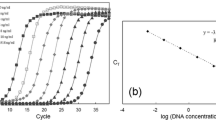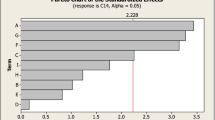Abstract
The objective of the experiment was to use starch processing waste as an alternative growth medium for cultivation of mycelia of the mushroom Phellinus linteus and to find an optimum condition under solid-state cultivation. Response surface analysis along with a central composite design was successfully applied to approximate the simultaneous effects of the substrate concentration (16–36 g l−1), pH (4.5–6.5), and temperature (25–35 °C) on the mycelial growth rate. In the model, pH and temperature significantly affected the mycelial growth but substrate concentration did not. The optimal substrate concentration, pH, and temperature for maximizing growth rate of P. linteus mycelia were found to be 16.5 g l−1, pH 6.0, and 29.7 °C, respectively. Subsequent verification of these levels agreed with model predictions and the maximum mycelial growth rate at these conditions was 6.1 ± 0.8 mm day−1. Therefore, the results of the experiments suggest that starch processing waste could be utilized as a growth substrate for the cultivation of the mushroom mycelia of P. linteus, enhancing the usefulness of this byproduct of the starch manufacturing industry. This approach is likely to be useful for establishing similar parameters for the cultivation of other fungi.




Similar content being viewed by others
References
Amitai G, Adani R, Sod-Moriah G, Rabinovitz I, Vincze A, Leader H, Chefetz B, Leibovitz-Persky L, Friesem D, Hadar Y (1998) Oxidative biodegradation of phosphorothiolates by fungal laccase. FEBS Lett 438:195–200
APHA (2005) Standard methods for the examination of water and wastewater, 21st edn. American Public Health Association, Washington, DC
Barampouti EMP, Mai ST, Vlyssides AG (2005) Dynamic modeling of the ratio volatile fatty acids/bicarbonate alkalinity in a UASB reactor for potato processing wastewater treatment. Environ Monit Assess 110:121–128
Bhak G, Song M, Lee S, Hwang S (2005) Response surface analysis of solid state growth of Pleurotus ostreatus mycelia utilizing whey permeate. Biotechnol Lett 27:1537–1541
Cho JH, Cho SD, Hu HB, Kim SH, Lee SK, Lee YS, Kang KS (2002) The roles of ERK1/2 and p38 MAP kinases in the preventive mechanisms of mushroom Phellinus linteus against the inhibition of gap junctional intercellular communication by hydrogen peroxide. Carcinogenesis 23:1163–1169
Deng SB, Bai RB, Hu XM, Luo Q (2003) Characteristics of a bioflocculant produced by Bacillus mucilaginosus and its use in starch wastewater treatment. Appl Microbiol Biotechnol 60:588–593
Fountoulakis MS, Dokianakis SN, Kornaros ME, Aggelis GG, Lyberatos G (2002) Removal of phenolics in olive mill wastewaters using the white-rot fungus Pleurotus ostreatus. Water Res 36:4735–4744
Hatvani N, Mećs I (2001) Production of laccase and manganese peroxidase by Lentinus edodes on malt-containing by-product of the brewing process. Process Biochem 37:491–496
Hwang HJ, Kim SW, Choi JW, Yun JW (2003) Production and characterization of exopolysaccharides from submerged culture of Phellinus linteus KCTC 6190. Enzyme Microb Technol 33:309–319
Jin B, van Leeuwen HJ, Patel B, Yu Q (1998) Utilisation of starch processing wastewater for production of microbial biomass protein and fungal alpha-amylase by Aspergillus oryzae. Bioresour Technol 66:201–206
Jin B, Yan XQ, Yu Q, van Leeuwen JH (2002) A comprehensive pilot plant system for fungal biomass protein production and wastewater reclamation. Adv Environ Res 6:179–189
Kim DH, Yang BK, Jeong SC, Park JB, Cho SP, Das S, Yun JW, Song CH (2001) Production of a hypoglycemic, extracellular polysaccharide from the submerged culture of the mushroom, Phellinus linteus. Biotechnol Lett 23:513–517
Kim GY, Choi GS, Lee SH, Park YM (2004) Acidic polysaccharide isolated from Phellinus linteus enhances through the up-regulation of nitric oxide and tumor necrosis factor-alpha from peritoneal macrophages. J Ethnopharmacol 95:69–76
Lim JM, Yun JW (2006) Enhanced production of exopolysaccharides by supplementation of toluene in submerged culture of an edible mushroom Collybia maculata TG-1. Process Biochem 41:1620–1626
Medeiros MB, Bento AV, Nunes ALL, Oliveira SC (1999) Optimization of some variables that affect the synthesis of laccase by Pleurotus ostreatus. Bioprocess Biosyst Eng 21:483–487
Morais H, Forgacs E, Cserhati T (2005) The use of spectral mapping for the study of the enzyme production of the edible mushroom Pleurotus ostreatus. Acta Aliment 34:121–130
Morais H, Ramos C, Matos N, Forgacs E, Cserhati T, Almeida V, Oliveira J, Darwish Y, Illes Z (2002) Liquid chromatographic and electrophoretic characterisation of extracellular beta-glucosidase of Pleurotus ostreatus grown in organic waste. J Chromatogr B 770:111–119
Myers RH, Montagomery DC (1995) Response surface methodology. Wiley, New York
Nakamura T, Matsugo S, Uzuka Y, Matsuo S, Kawagishi H (2004) Fractionation and anti-tumor activity of the mycelia of liquid-cultured Phellinus linteus. Biosci Biotechnol Biochem 68:868–872
Ruiz-Aguilar GML, Fernandez-Sanchez JM, Rodriguez-Vazquez R, Poggi-Varaldo H (2002) Degradation by white-rot fungi of high concentrations of PCB extracted from a contaminated soil. Adv Environ Res 6:559–568
Shi XM, Liu HJ, Zhang XW, Chen F (1999) Production of biomass and lutein by Chlorella protothecoides at various glucose concentrations in heterotrophic cultures. Process Biochem 4:341–347
Shon YH, Nam KS (2001) Antimutagenicity and induction of anticarcinogenic phase II enzymes by basidiomycetes. J Ethnopharmacol 77:103–109
Song M, Kim N, Lee S, Hwang S (2007) Use of whey permeate for cultivating Ganoderma lucidum mycelia. J Dairy Sci 90:2141–2146
Acknowledgments
This research was supported in part by the BK-21 program, Advanced Environmental Biotechnology Research Center (AEBRC) (Grant No: R11-2003-006-02002-0), and Ministry of Environment as “The Eco-technopia 21 project.”
Author information
Authors and Affiliations
Corresponding author
Rights and permissions
About this article
Cite this article
Lee, S., Bae, H., Song, M. et al. Bioconversion of starch processing waste to Phellinus linteus mycelium in solid-state cultivation. J Ind Microbiol Biotechnol 35, 859–865 (2008). https://doi.org/10.1007/s10295-008-0358-1
Received:
Accepted:
Published:
Issue Date:
DOI: https://doi.org/10.1007/s10295-008-0358-1




